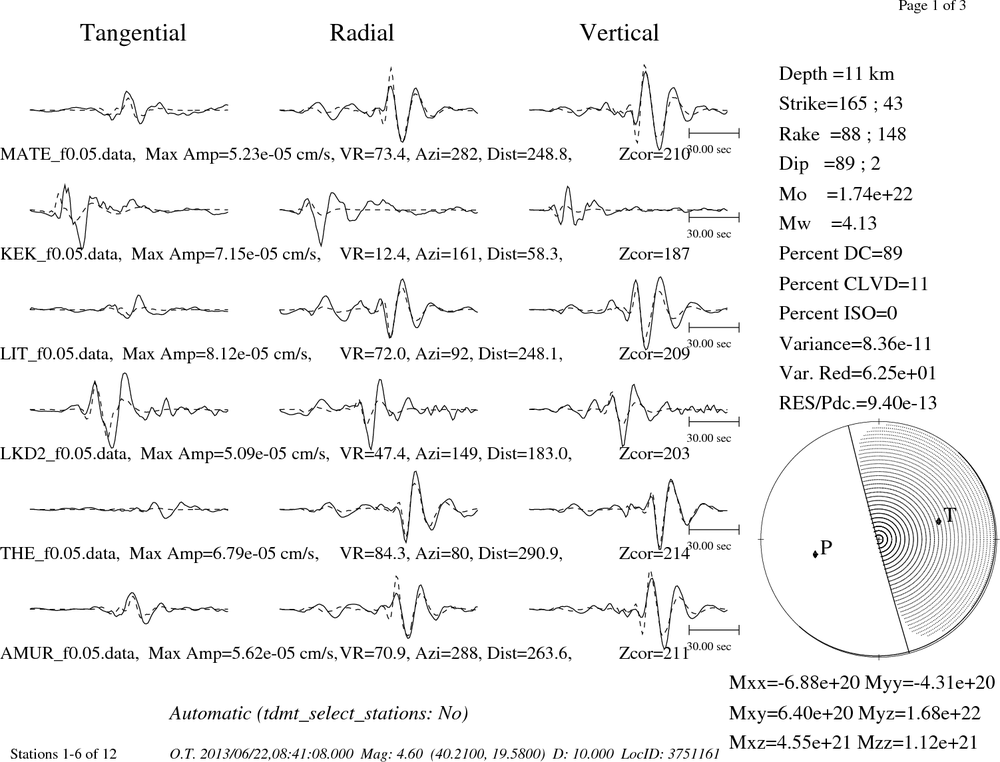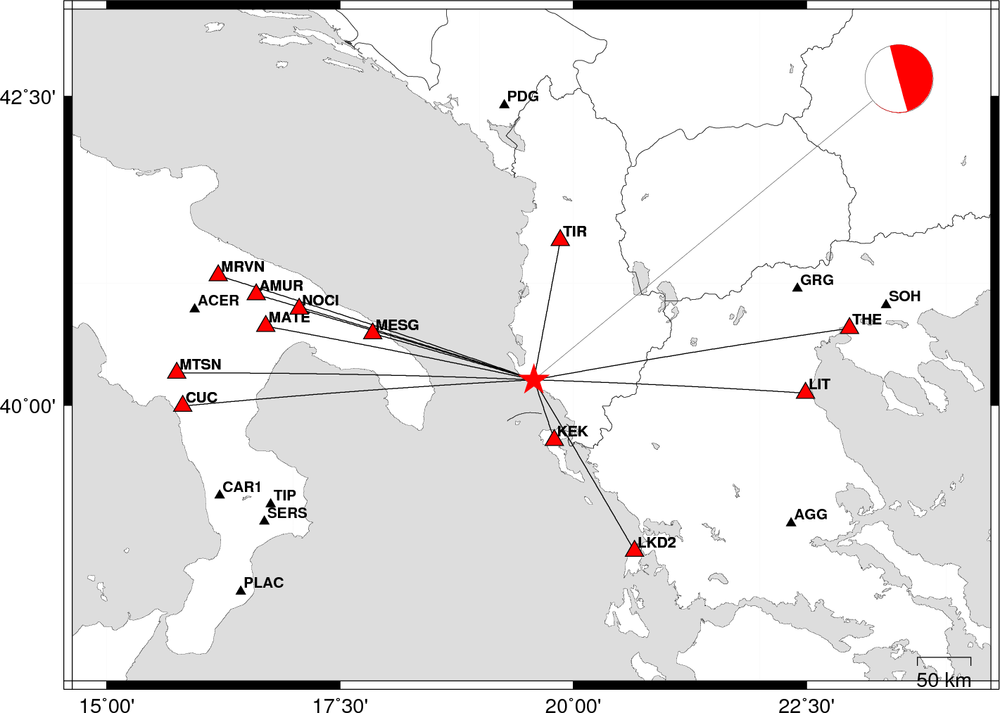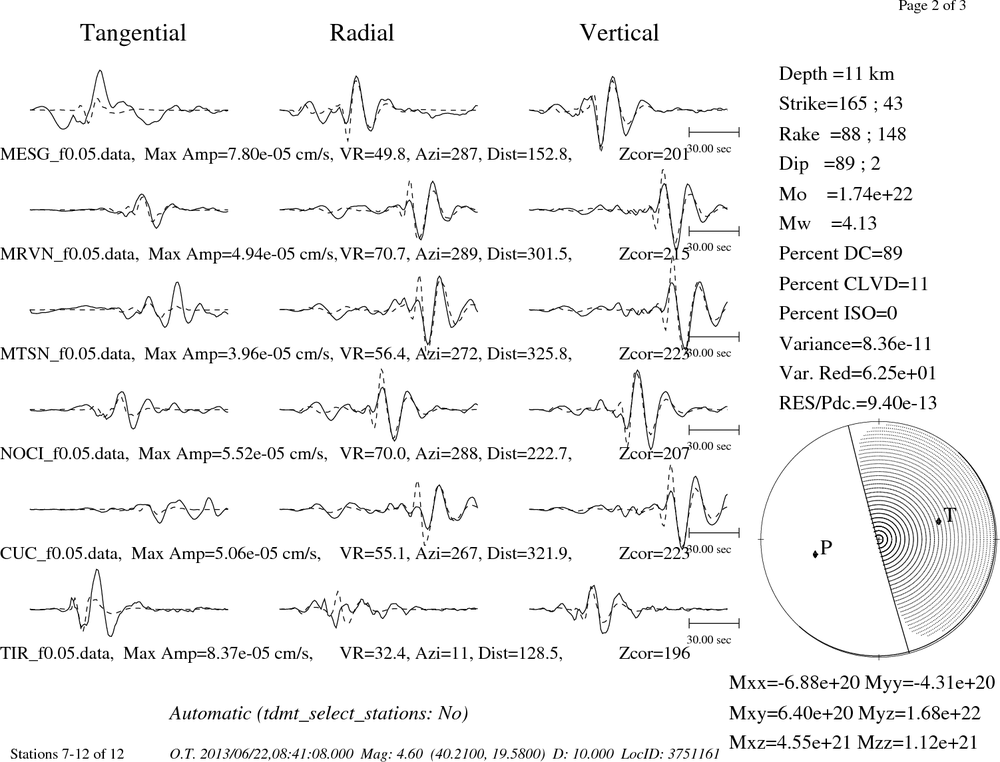Location
2013/06/22 08:41:09 40.24 19.56 10.0 4.50 Albania
Arrival Times (from USGS)
Arrival time list
Felt Map
USGS Felt map for this earthquake
USGS Felt reports archive
Focal Mechanism
USGS/SLU Moment Tensor Solution
ENS 2013/06/22 08:41:09:0 40.24 19.56 10.0 4.5 Albania
Stations used:
BS.PLD GE.KYTH HL.KEK HT.AGG HT.ALN HT.GRG HT.KNT HT.LIT
HT.LKD2 HT.SIGR HT.SOH HT.SRS HT.THE HT.XOR MN.BLY MN.PDG
MN.TIR MN.VTS SJ.FRGS
Filtering commands used:
hp c 0.02 n 3
lp c 0.07 n 3
Best Fitting Double Couple
Mo = 3.20e+22 dyne-cm
Mw = 4.27
Z = 20 km
Plane Strike Dip Rake
NP1 168 71 107
NP2 305 25 50
Principal Axes:
Axis Value Plunge Azimuth
T 3.20e+22 60 102
N 0.00e+00 16 342
P -3.20e+22 24 245
Moment Tensor: (dyne-cm)
Component Value
Mxx -4.43e+21
Mxy -1.18e+22
Mxz 2.21e+21
Myy -1.43e+22
Myz 2.43e+22
Mzz 1.88e+22
##------------
######----------------
###-----##########----------
#--------##############-------
-----------################-------
------------##################------
-------------####################-----
--------------#####################-----
--------------######################----
----------------######################----
----------------########### #########---
----------------########### T #########---
-----------------########## #########---
---- ---------######################--
---- P ----------#####################--
--- ----------#####################-
----------------####################
----------------##################
---------------###############
---------------#############
-------------#########
-----------###
Global CMT Convention Moment Tensor:
R T P
1.88e+22 2.21e+21 -2.43e+22
2.21e+21 -4.43e+21 1.18e+22
-2.43e+22 1.18e+22 -1.43e+22
Details of the solution is found at
http://www.eas.slu.edu/eqc/eqc_mt/MECH.EU/20130622084109/index.html
|
Preferred Solution
The preferred solution from an analysis of the surface-wave spectral amplitude radiation pattern, waveform inversion and first motion observations is
STK = 305
DIP = 25
RAKE = 50
MW = 4.27
HS = 20.0
The waveform inversion is preferred.
Moment Tensor Comparison
The following compares this source inversion to others
| SLU |
INGVTDMT |
USGS/SLU Moment Tensor Solution
ENS 2013/06/22 08:41:09:0 40.24 19.56 10.0 4.5 Albania
Stations used:
BS.PLD GE.KYTH HL.KEK HT.AGG HT.ALN HT.GRG HT.KNT HT.LIT
HT.LKD2 HT.SIGR HT.SOH HT.SRS HT.THE HT.XOR MN.BLY MN.PDG
MN.TIR MN.VTS SJ.FRGS
Filtering commands used:
hp c 0.02 n 3
lp c 0.07 n 3
Best Fitting Double Couple
Mo = 3.20e+22 dyne-cm
Mw = 4.27
Z = 20 km
Plane Strike Dip Rake
NP1 168 71 107
NP2 305 25 50
Principal Axes:
Axis Value Plunge Azimuth
T 3.20e+22 60 102
N 0.00e+00 16 342
P -3.20e+22 24 245
Moment Tensor: (dyne-cm)
Component Value
Mxx -4.43e+21
Mxy -1.18e+22
Mxz 2.21e+21
Myy -1.43e+22
Myz 2.43e+22
Mzz 1.88e+22
##------------
######----------------
###-----##########----------
#--------##############-------
-----------################-------
------------##################------
-------------####################-----
--------------#####################-----
--------------######################----
----------------######################----
----------------########### #########---
----------------########### T #########---
-----------------########## #########---
---- ---------######################--
---- P ----------#####################--
--- ----------#####################-
----------------####################
----------------##################
---------------###############
---------------#############
-------------#########
-----------###
Global CMT Convention Moment Tensor:
R T P
1.88e+22 2.21e+21 -2.43e+22
2.21e+21 -4.43e+21 1.18e+22
-2.43e+22 1.18e+22 -1.43e+22
Details of the solution is found at
http://www.eas.slu.edu/eqc/eqc_mt/MECH.EU/20130622084109/index.html
|
|
Waveform Inversion
The focal mechanism was determined using broadband seismic waveforms. The location of the event and the
and stations used for the waveform inversion are shown in the next figure.

|
|
Location of broadband stations used for waveform inversion
|
The program wvfgrd96 was used with good traces observed at short distance to determine the focal mechanism, depth and seismic moment. This technique requires a high quality signal and well determined velocity model for the Green functions. To the extent that these are the quality data, this type of mechanism should be preferred over the radiation pattern technique which requires the separate step of defining the pressure and tension quadrants and the correct strike.
The observed and predicted traces are filtered using the following gsac commands:
hp c 0.02 n 3
lp c 0.07 n 3
The results of this grid search from 0.5 to 19 km depth are as follow:
DEPTH STK DIP RAKE MW FIT
WVFGRD96 0.5 170 45 90 3.87 0.2781
WVFGRD96 1.0 350 45 90 3.90 0.2624
WVFGRD96 2.0 350 45 90 4.02 0.3367
WVFGRD96 3.0 350 50 90 4.07 0.3005
WVFGRD96 4.0 140 45 40 4.03 0.2731
WVFGRD96 5.0 135 40 30 4.02 0.2746
WVFGRD96 6.0 280 15 10 4.04 0.2937
WVFGRD96 7.0 280 20 10 4.04 0.3290
WVFGRD96 8.0 290 15 25 4.14 0.3559
WVFGRD96 9.0 290 15 25 4.15 0.3943
WVFGRD96 10.0 295 20 30 4.16 0.4266
WVFGRD96 11.0 300 20 35 4.18 0.4550
WVFGRD96 12.0 330 20 75 4.21 0.4794
WVFGRD96 13.0 310 25 55 4.21 0.5005
WVFGRD96 14.0 310 25 55 4.22 0.5191
WVFGRD96 15.0 310 25 55 4.23 0.5333
WVFGRD96 16.0 310 25 55 4.24 0.5441
WVFGRD96 17.0 310 25 55 4.25 0.5518
WVFGRD96 18.0 310 25 55 4.26 0.5570
WVFGRD96 19.0 305 25 50 4.27 0.5602
WVFGRD96 20.0 305 25 50 4.27 0.5609
WVFGRD96 21.0 305 25 50 4.29 0.5604
WVFGRD96 22.0 305 25 50 4.30 0.5576
WVFGRD96 23.0 305 25 50 4.31 0.5536
WVFGRD96 24.0 305 25 50 4.31 0.5487
WVFGRD96 25.0 305 25 50 4.32 0.5422
WVFGRD96 26.0 335 30 70 4.32 0.5364
WVFGRD96 27.0 335 30 70 4.33 0.5329
WVFGRD96 28.0 335 30 70 4.34 0.5283
WVFGRD96 29.0 330 35 60 4.35 0.5227
The best solution is
WVFGRD96 20.0 305 25 50 4.27 0.5609
The mechanism correspond to the best fit is

|
|
Figure 1. Waveform inversion focal mechanism
|
The best fit as a function of depth is given in the following figure:

|
|
Figure 2. Depth sensitivity for waveform mechanism
|
The comparison of the observed and predicted waveforms is given in the next figure. The red traces are the observed and the blue are the predicted.
Each observed-predicted component is plotted to the same scale and peak amplitudes are indicated by the numbers to the left of each trace. A pair of numbers is given in black at the right of each predicted traces. The upper number it the time shift required for maximum correlation between the observed and predicted traces. This time shift is required because the synthetics are not computed at exactly the same distance as the observed and because the velocity model used in the predictions may not be perfect.
A positive time shift indicates that the prediction is too fast and should be delayed to match the observed trace (shift to the right in this figure). A negative value indicates that the prediction is too slow. The lower number gives the percentage of variance reduction to characterize the individual goodness of fit (100% indicates a perfect fit).
The bandpass filter used in the processing and for the display was
hp c 0.02 n 3
lp c 0.07 n 3

|
|
Figure 3. Waveform comparison for selected depth
|

|
|
Focal mechanism sensitivity at the preferred depth. The red color indicates a very good fit to thewavefroms.
Each solution is plotted as a vector at a given value of strike and dip with the angle of the vector representing the rake angle, measured, with respect to the upward vertical (N) in the figure.
|
A check on the assumed source location is possible by looking at the time shifts between the observed and predicted traces. The time shifts for waveform matching arise for several reasons:
- The origin time and epicentral distance are incorrect
- The velocity model used for the inversion is incorrect
- The velocity model used to define the P-arrival time is not the
same as the velocity model used for the waveform inversion
(assuming that the initial trace alignment is based on the
P arrival time)
Assuming only a mislocation, the time shifts are fit to a functional form:
Time_shift = A + B cos Azimuth + C Sin Azimuth
The time shifts for this inversion lead to the next figure:

The derived shift in origin time and epicentral coordinates are given at the bottom of the figure.
Discussion
The Future
Should the national backbone of the
USGS Advanced National Seismic System (ANSS)
be implemented with an interstation separation of 300 km, it is very likely that
an earthquake such as this would have been recorded at distances on the order of
100-200 km. This means that the closest station would have information on
source depth and mechanism that was lacking here.
Acknowledgements
Dr. Harley Benz, USGS, provided the USGS USNSN digital data.
The digital data used in this study were provided by Natural Resources Canada through their AUTODRM site http://www.seismo.nrcan.gc.ca/nwfa/autodrm/autodrm_req_e.php, and IRIS using their BUD interface.
Thanks also to the many seismic network operators whose dedication make this effort possible: University of Alaska, University of Washington, Oregon State University, University of Utah, Montana Bureas of Mines, UC Berkely, Caltech, UC San Diego, Saint L ouis University, Universityof Memphis, Lamont Doehrty Earth Observatory, Boston College, the Iris stations and the Transportable Array of EarthScope.
Velocity Model
The WUS used for the waveform synthetic seismograms and for the surface wave eigenfunctions and dispersion is as follows:
MODEL.01
Model after 8 iterations
ISOTROPIC
KGS
FLAT EARTH
1-D
CONSTANT VELOCITY
LINE08
LINE09
LINE10
LINE11
H(KM) VP(KM/S) VS(KM/S) RHO(GM/CC) QP QS ETAP ETAS FREFP FREFS
1.9000 3.4065 2.0089 2.2150 0.302E-02 0.679E-02 0.00 0.00 1.00 1.00
6.1000 5.5445 3.2953 2.6089 0.349E-02 0.784E-02 0.00 0.00 1.00 1.00
13.0000 6.2708 3.7396 2.7812 0.212E-02 0.476E-02 0.00 0.00 1.00 1.00
19.0000 6.4075 3.7680 2.8223 0.111E-02 0.249E-02 0.00 0.00 1.00 1.00
0.0000 7.9000 4.6200 3.2760 0.164E-10 0.370E-10 0.00 0.00 1.00 1.00
Quality Control
Here we tabulate the reasons for not using certain digital data sets
The following stations did not have a valid response files:
DATE=Mon Jun 24 01:14:13 CDT 2013
Last Changed 2013/06/22








